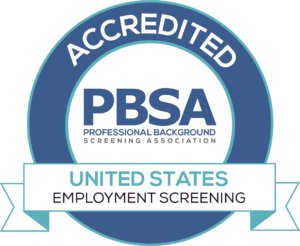Overview: The History of Background Checks
Background screening is a relatively new practice. Just a few decades ago, determinations of job or creditworthiness were generally made in good faith— resting largely on the words and confidence of applicants.
In recent years, due to improved technology, data has become more of a focus. It is easier to store and easier to retrieve. Criminal history, driving history, employment history, and credit history are much easier to gather, and results are much more accurate than in times past.
In short, background screening has its history. The history of employment background checks can be relevant to employers who currently have processes in place, allowing for a better understanding of the legalities surrounding them.

The Emergence of Negligent Hiring Laws
When all is said and done, it is the employer’s responsibility to take reasonable steps to ensure the safety of their existing employees, customers, and associates. If an employee engages in violent or criminal behavior, the employer could be charged with negligent hiring and held liable for the damages caused.
The law pertaining to negligent hiring was first introduced in 1908 in a case where a prank by an apprentice resulted in the accidental killing of a co-worker. In that case, the court held the employer liable for the death as it found that the employer had continued to keep the wrongdoer in employment even after witnessing a pattern of reckless behavior.
The negligent hiring law was expanded between 1911 and 1933 to include actions that took place outside of employment (such as hiring an individual with a known violent disposition) and violent acts against customers by employees. In 1951, a case was filed against a delivery person who made an “indecent attack” on a woman. The court held that the employer had the responsibility to exercise reasonable care while selecting workers to choose only those who were fit and competent for the job assigned, particularly because these workers directly engaged with the public.
Many more employers over the two decades that followed were held liable by the US courts on the charge of negligent hiring. As a result, by the late 1970s, employers across different industries began focusing on providing a safer work environment and started scrutinizing resumes and job applications for false information.
Increasing Reliance on Professional Background Check Service Providers
During the 1990s, a growing number of employers began to recognize the need to involve professional background screening service providers in the hiring process. These professionals developed the tools, resources, and techniques to obtain critical background information about job applicants that could provide insights into their personality and skills.
In 1993, the Brady Handgun Violence Prevention Act was passed. This act required firearm buyers to undergo a criminal background check conducted by the federal government. Just a few years later, the National Instant Criminal Background Check System (NICS) was developed and is still in use today. Because of some issues with this system, private screening providers started emerging in greater numbers and delivering accurate, effective, and timely name-based criminal screening products to employers around the globe.
In 2003, the National Association of Professional Background Screeners (NAPBS)— now the Professional Background Screening Association— was founded to promote the cause of third-party screening services. The organization also provides guidance to background check professionals about maintaining ethical standards and staying on the right side of the law while conducting their candidate screening.
The result has been a culture of commitment to upholding compliance with the FCRA (Fair Credit Reporting Act), protecting consumer privacy, and following fair business practices among PBSA-accredited background screening partners.
Two Pivotal Events
In addition to evolving laws and screening practices, there are two 21st-century events that have changed the landscape of employment screening.
Prior to 2001, workplace safety was certainly a focus but perhaps not a priority. It wasn’t until after the events of 9/11 that employers, on a mass scale, began defining and implementing more deliberate screening programs. Since this time, organizations across most industries have considered employment screening a safety must— a conclusion that data tends to support.
The second key event was, of course, the global COVID-19 pandemic. The pandemic not only affected employment rates and hiring trends, but it effectively changed how many (perhaps the majority) of employees work. Since 2020, a significant portion of the world’s workforce carries out their duties entirely remotely. This has created a need for improved background screening standards and practices as more trust is required now than ever before between employees and their employers.
Small/Medium Companies and the History of Background Checks
In the last two decades, there has been rising awareness among small and mid-sized companies about the potential costs and risks of negligent hiring and what kind of damages and losses may occur if the wrong employee makes their way through the doors.
Employers are now increasingly inclined to conduct pre-employment checks related to identity verification, criminal history, verification of academic qualifications, drug tests, and employment verification.
As time continues, screening practices and methods are growing more and more efficient. Turnaround times are decreasing while accuracy and report detail are increasing. Organizations are leveraging screening data in new ways to not only vet their candidates and new hires but to better promote workplace safety and reduce their turnover. Background checks have certainly come a long way and will continue to evolve into the future.
For more information about safe, effective employment screening practices, pay us a visit online.








